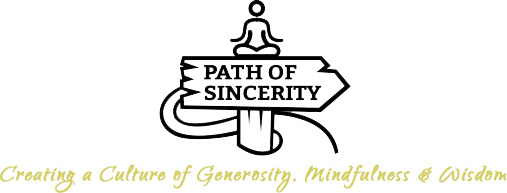
In today’s post, we’re going to more directly explore the realm of meditative truth.
Of course, just as you don’t need to read about gravity to experience it, you don’t need to read about these to experience them, or to have insight into them. However, knowing where to steer your practice can sure save a lot of time.
As a basic formula, meditative insight largely comes through applying our meditation fundamentals: being mindful with a curious and equanimous attitude, moment-after-moment-after-moment.
Without further ado, here they are:
 1) Impermanence / Inconstancy
1) Impermanence / Inconstancy
This insight is the foundation of all the other insights. It is not the abstract idea that all that is born will eventually die, or that all things change. Instead, it is more earthy and immediate—it’s a moment-by-moment perception.
For example, rub your hands together for a few seconds. Then, notice the sensations in your left palm. You’ll notice they are rapidly pulsating and vibrating many times per second.
As our awareness stabilizes in the present, we start to notice that all our experience is in a similar state of moment-by-moment change.
Nothing is static. Sights, sounds, tastes, smells, sensations. All of them are rapidly changing every micro-moment. The same with our thoughts, feelings, emotions, impulses and even attention itself.
Perhaps the most profound meditation instruction is this: notice the experience of change, moment-by-moment-by-moment.
And, from this place of noticing present-moment-change so lucidly, the other two insights naturally follow.
![]() 2) Not-self
2) Not-self
In most Eastern Spiritual traditions, what’s called “enlightenment” usually refers to a 10.0 insight into not-self. Although, regardless of the insight’s magnitude, it means that we realize any (or all) of the following truths:
- I am not my thoughts
- I am not my body sensations
- I am not my feelings, emotions or mental states
- I am not my beliefs or values
- I am not the sum total of my roles, relationships or undertakings
- Past and future are an illusion (this moment is all there is)
- Life is not so serious
Our conventional way of living involves blind reactivity, being on autopilot, taking life really seriously, and “identifying” with those first few things in bullet points. Sometimes this is called the “dream state.”
Realizing not-self is like becoming lucid amidst the dream.
Of course, we still have thoughts, emotions, values and relationships, and understand the importance of past/future. We’re still just as much a person and a self as ever.
However, life doesn’t feel so serious anymore. It’s just like the difference between regular dreaming and lucid dreaming. When we realize it’s all a dream, everything becomes more spacious, and we suddenly find a profound degree of choice on how we wish to show up in the world.
To put it more technically, our baseline “sense of self” shifts from the contents of awareness, like thoughts and emotions, to the simple awareness of whatever is changing moment-by-moment-by-moment.
It’s relevant to consider why it’s called “not-self.”
It’s because anything we can find in our present-moment-experience is changing. If we carefully direct our attention to the present, we’ll see all those things changing in real-time. And, if something is changing, then it can’t be us! It’s just a thing we’re noticing that’s inconstant!
In a future post, I’ll more clearly describe the two primary meditation strategies for realizing not-self.
But, for now, I’ll leave you with one classic meditative question: “who am I?” Sitting with this question invites us to explore in real-time, “what is not changing?” This inquiry itself can take you all the way!
 3) Dukkha (aka suffering)
3) Dukkha (aka suffering)
Classically, the main purpose of mindfulness meditation is to swap dukkha for inner freedom. Although, instead of giving a big review of dukkha, I’ll just talk about the two ways that this insight is most relevant in mindfulness meditation.
A) Realizing the pain of the dream state.
As we develop our awareness skills, we notice that there’s something fundamentally painful about being on autopilot, living in reactivity, or “identifying” with our thoughts, feelings and emotions.
In turn, one of the deepest insights into dukkha comes from simply noticing how life is smooth and peaceful when we’re lucidly aware, and painful and nauseating when we’re stuck in the dream state.
B) Realizing the pain of wanting things to be other than they are.
Sometimes called craving and aversion, this can happen on the conscious level and on the subconscious level.
On the conscious level, our minds are constantly in a state of pushing away some experiences, and pulling in other experiences. Anything but just being with what is. For example:
I want a banana. I don’t want to talk to that person. I want to veg-out for another five minutes. I don’t want to go out in the cold. I want that loud sound to stop. I don’t want to feel this shame. I want to think this thought that just popped into my mind.
There’s something fundamentally painful and nauseating about being reactively guided by the whims of these feelings and thoughts.
On the subconscious level, we hold views, beliefs or values that are setting us up for pain and unhappiness. Maybe we have a belief that says, unless I’m professionally successful, then I’m a worthless person. Or a view that says, I’ve got to meditate really intensely and be perfectly aware. Or maybe we hold some deep value of cheap stimulation, aggressiveness or material success.
Our mind is like a fancy computer program, and these subconscious views directly bubble up into conscious-level feelings, thoughts and the whole push/pull dynamic.
To have an insight into dukkha basically means we realize something we’re doing is suffering, or we realize a way we can let go of that suffering.
Sometimes the process is compared to holding a hot coal. We might be so caught in distraction that we don’t even realize it. But the second we realize that this hot object is in our hand, the realization itself is enough to get us to release it.
 Summary
Summary
I often think of awakening or inner freedom as a journey of 10,000 steps. Each little moment of lucid awareness is like one baby step. Some people make it to 10,000 simply through decades of baby steps (aka insights of magnitude .2).
However, the more we incline our mind to these three truths, the more we set ourselves up for higher magnitude insights.
In the next post, I’ll explain more clearly why it’s helpful to read this information and have an intellectual understanding of these truths:
- Introducing Insight and Wisdom in Mindfulness Meditation (Part 1)
- How to Measure the Strength of an Insight (Part 2)
- The Difference between “Psychological” and “Meditative” Insight (Part 3)
- The Three Core Insights of Mindfulness Meditation (Part 4)
- How to Attain Wisdom & Insight in Three Steps (Part 5)
- Six Important Things to Know after a Major Insight (Part 6)
